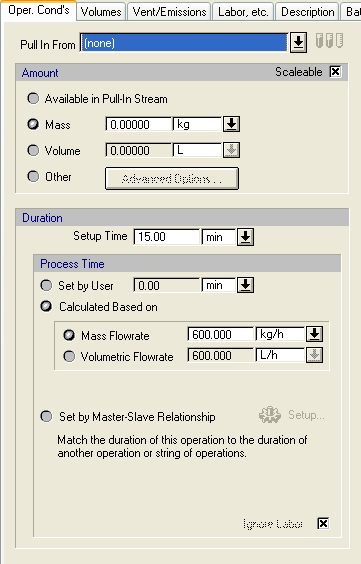

The following table shows a brief description of the variables appearing in this tab. The table also displays their default values and their generally acceptable range:
|
Variable |
Default Value |
Range |
|
|
||
|
○ Pull In From Port / Stream |
<None> |
Any Input Port |
|
○ Scalable |
Yes |
Yes/No |
|
◙ Mass (kg) |
0.0 |
Positive |
|
◙ Volume (L) |
0.0 |
Positive |
|
○ Setup Time (min) |
15.0 |
Positive |
|
◙ Process Time (min) |
0.0 |
Positive |
|
◙ Mass Flowrate (kg/h) |
600.0 |
Positive |
|
◙ Volumetric Flowrate (L/h) |
0.0 |
Positive |
|
○ Ignore Labor? |
Yes |
Yes/No |
Symbol Key: ○ User-specified value (always input); ● Calculated value (always output); ◙ Sometimes input, sometimes output
The following list describes the available specification choices in this tab; for more details on how these are implemented, see Pull In: Modeling Calculations.
•Pull In stream...
You must always select a pull-in stream. The pull-in stream can be either an input stream of the procedure that this operation is participating, or an intermediate stream, output of another procedure.
•Amount options...
There are four amount specifications options available:
a) Amount can is specified in the input stream (as in Charge / Transfer In operations)
b) Specify the pull in mass
c) Specify the pull in volume
d) Specify ‘Other’ properties
If you chose to specify the pull in mass / volume indicate whether the absolute amounts for flowrate are ‘Scalable’ with process throughput adjustment. (This implies that if the user chooses to adjust the process throughput by a factor the user-specified pull in mass/ volume will also be adjusted by the same factor.)
If the ‘Other’ amount option is chosen, click on the Advanced Options button to set the pull-in design specification, based on which pull-in amount will be calculated. See Pull-In Advanced Options Dialog.
•Duration options...
The duration of the operation can be calculated by the following ways:
a) Set directly the user
b) Calculated based on a user-specified mass or volume charge rate, or
c) Tied up to another operation or operation sequence by exploiting the Master-Slave relationship. If you introduce a master-slave relationship, the program will match the setup time, the process time and the turnaround time of this operation (the ‘slave’) with the corresponding times of the reference operation (the ‘master’ operation). For more details on how to setup a master-slave relationship, see The Scheduling Tab.
● Charge